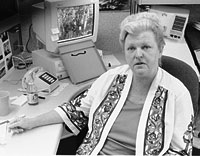|
Privatization Strikes San Diego CalWORKS Sept 2000 by Richard Bermack
San Diego
employment case managers used to brag about their model GAIN program. "When
the New York Times, or 60 Minutes, wanted to do a show on state-of-the-art
welfare-to-work programs, they came to us," San Diego employment case manager
Karol Lightner brags.
"We were a role model not just for the United States, but for the world.
We were doing an outstanding job of employment preparation," echoes Pat
Watters, another worker. She remembers officials from foreign countries
visiting the San Diego office to study their program. "The secret was spending the time with clients and giving them total
saturation," Watters explains. "We wouldn't let them out of the program.
Those who didn't get jobs, we stayed with them. We had small caseloads,
about 50 cases, and we kept the same clients. From the time they stepped
in the door, they stayed on your caseload, through job club and employment
activities. Not the assembly-line social work we do today, where the client
goes from worker to worker, creating more and more paperwork and less
people contact." Reorganization Then one day a conservative board of supervisors hired a conservative
county executive officer, who ordered a reorganization of county services.
Under the reorganization plan the Department of Social Services and the
Department of Health Services were combined into the Department of Health
and Human Services. The county was divided into six autonomous regions. As a result, many workers were assigned new supervisors and many supervisors
quit. The reorganization happened at about the same time as welfare reform,
with the new emphasis on welfare to work. "Before, maybe 50% of our clients
had to participate in job training. Now 100% have to participate," case
manager Bill Brown explains. According to Brown, the county said it needed
to hire 150 new workers, and the conservative county administration used
the excuse to hire private contractors rather than more county workers. The GAIN program was divided up, with two of the six regions going to
Maximus, one going to Lockheed-Martin, and one going to Catholic Charities.
The two remaining regions were left with the county workers. Under the
new program, referred to as "Managed Competition," county workers competed
against the private contractors. From the workers' point of view, the
results were chaos. "No one knew what was going on or who our new bosses
were," says Lightner. "And the administrators were as lost as we were.
It was scary for everyone.' Privatization is the future, get used to it,'
they told us. A lot of people got scared. Our best case managers left.
They went into CPS or IHSS, or they left the county altogether. Some went
to work for the private contractors." Managed Competition The San Diego County administrators devised a system in which the county workers compete against the private contractors. The contractors get paid according to performance and must submit documentation of the work they claim to have performed. Auditors then substantiate the documentation to guard against fraudulent billing. Applying some rather strange logic, county administrators imposed the same guidelines on county employees, claiming that it was the only way to create a level playing field. As a result, county workers are now required to complete whole new sets of documentation, and go through continual audits on the pay-for-performance forms, in addition to providing the documentation that was required previously by county, state, and federal regulations. "Now it is like we have auditors auditing the auditors," Lightner exclaims. "All the paperwork and computer work is mind numbing. It feels like having to go through a thorough physical examination once a week, and I do mean thorough. Case managers are afraid to go on vacation because they never know when the auditors are going to come in and demand to look at every detail in all your cases." What bothers her most is the new documentation has nothing to do with helping the clients. "All they care about are stats, and that if the contractor does it, we have to do it too. That's managed competition," she states. Watters did a survey of her fellow workers. She reports, "I talked to just about every case manager here, and about one-fourth to one-half of their work month is spent doing nothing but stats, and that does not count the regular paperwork we did before. That is just juggling the figures." She gives an example: "I spent all day Friday, all day Tuesday (I don't work Monday), and two-thirds of Wednesday just reconciling the figures. I had no time to see clients. That is all I did for three days." Not About Helping Clients Find Jobs What bothers workers most is that the only apparent purpose of the added work is to make their jobs more difficult, so that the private contractors' results will look better. "The kinds of things they are looking at are whether you write the words 'assessment done.," Watters says. "If you didn't write the words 'assessment done,' it is an error and you have to go back through all your cases and write 'assessment done.' Not only do I not see how it helps better serve clients, but I don't even see how it's useful for comparing the jobs we are doing. I could see it if we were comparing how many clients got off welfare or how many clients got clean and sober. That is something worth counting. But how many cases have the word 'assessment done?'" Brown is also concerned that the program's priorities are all backward. "There are no statistics kept on counseling clients, on sitting with them and helping them," he explains. "That has become the lowest priority. The priority is to prove the clients have done their 128 hours of job club and job search. That is what you have to document, that that component was met. Whether or not more people are going to work has become less of a priority. Many people have gotten off the rolls, but it is because of the economy, not what we are doing." Workers feel that the county's reasons for privatizing were entirely ideological. According to one worker, the board of supervisors hired a CEO from the military/electronics industry, who stated that if you could find it in the phone book, it should be privatized. And that is what he intended to do, no matter what justification he had to use. On September 8, 2000, Superior Court Judge J. Richard Haden ruled that San Diego County had abused its discretionary power in contracting out the CalWORKS program and ordered the contracts terminated. The county is expected to appeal the decision. |
||||||||



